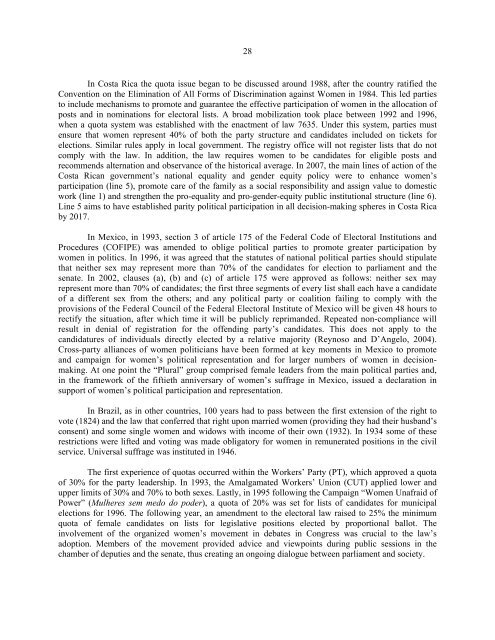Women in Latin America and the Caribbean - Cepal
Women in Latin America and the Caribbean - Cepal
Women in Latin America and the Caribbean - Cepal
Create successful ePaper yourself
Turn your PDF publications into a flip-book with our unique Google optimized e-Paper software.
28<br />
In Costa Rica <strong>the</strong> quota issue began to be discussed around 1988, after <strong>the</strong> country ratified <strong>the</strong><br />
Convention on <strong>the</strong> Elim<strong>in</strong>ation of All Forms of Discrim<strong>in</strong>ation aga<strong>in</strong>st <strong>Women</strong> <strong>in</strong> 1984. This led parties<br />
to <strong>in</strong>clude mechanisms to promote <strong>and</strong> guarantee <strong>the</strong> effective participation of women <strong>in</strong> <strong>the</strong> allocation of<br />
posts <strong>and</strong> <strong>in</strong> nom<strong>in</strong>ations for electoral lists. A broad mobilization took place between 1992 <strong>and</strong> 1996,<br />
when a quota system was established with <strong>the</strong> enactment of law 7635. Under this system, parties must<br />
ensure that women represent 40% of both <strong>the</strong> party structure <strong>and</strong> c<strong>and</strong>idates <strong>in</strong>cluded on tickets for<br />
elections. Similar rules apply <strong>in</strong> local government. The registry office will not register lists that do not<br />
comply with <strong>the</strong> law. In addition, <strong>the</strong> law requires women to be c<strong>and</strong>idates for eligible posts <strong>and</strong><br />
recommends alternation <strong>and</strong> observance of <strong>the</strong> historical average. In 2007, <strong>the</strong> ma<strong>in</strong> l<strong>in</strong>es of action of <strong>the</strong><br />
Costa Rican government’s national equality <strong>and</strong> gender equity policy were to enhance women’s<br />
participation (l<strong>in</strong>e 5), promote care of <strong>the</strong> family as a social responsibility <strong>and</strong> assign value to domestic<br />
work (l<strong>in</strong>e 1) <strong>and</strong> streng<strong>the</strong>n <strong>the</strong> pro-equality <strong>and</strong> pro-gender-equity public <strong>in</strong>stitutional structure (l<strong>in</strong>e 6).<br />
L<strong>in</strong>e 5 aims to have established parity political participation <strong>in</strong> all decision-mak<strong>in</strong>g spheres <strong>in</strong> Costa Rica<br />
by 2017.<br />
In Mexico, <strong>in</strong> 1993, section 3 of article 175 of <strong>the</strong> Federal Code of Electoral Institutions <strong>and</strong><br />
Procedures (COFIPE) was amended to oblige political parties to promote greater participation by<br />
women <strong>in</strong> politics. In 1996, it was agreed that <strong>the</strong> statutes of national political parties should stipulate<br />
that nei<strong>the</strong>r sex may represent more than 70% of <strong>the</strong> c<strong>and</strong>idates for election to parliament <strong>and</strong> <strong>the</strong><br />
senate. In 2002, clauses (a), (b) <strong>and</strong> (c) of article 175 were approved as follows: nei<strong>the</strong>r sex may<br />
represent more than 70% of c<strong>and</strong>idates; <strong>the</strong> first three segments of every list shall each have a c<strong>and</strong>idate<br />
of a different sex from <strong>the</strong> o<strong>the</strong>rs; <strong>and</strong> any political party or coalition fail<strong>in</strong>g to comply with <strong>the</strong><br />
provisions of <strong>the</strong> Federal Council of <strong>the</strong> Federal Electoral Institute of Mexico will be given 48 hours to<br />
rectify <strong>the</strong> situation, after which time it will be publicly reprim<strong>and</strong>ed. Repeated non-compliance will<br />
result <strong>in</strong> denial of registration for <strong>the</strong> offend<strong>in</strong>g party’s c<strong>and</strong>idates. This does not apply to <strong>the</strong><br />
c<strong>and</strong>idatures of <strong>in</strong>dividuals directly elected by a relative majority (Reynoso <strong>and</strong> D’Angelo, 2004).<br />
Cross-party alliances of women politicians have been formed at key moments <strong>in</strong> Mexico to promote<br />
<strong>and</strong> campaign for women’s political representation <strong>and</strong> for larger numbers of women <strong>in</strong> decisionmak<strong>in</strong>g.<br />
At one po<strong>in</strong>t <strong>the</strong> “Plural” group comprised female leaders from <strong>the</strong> ma<strong>in</strong> political parties <strong>and</strong>,<br />
<strong>in</strong> <strong>the</strong> framework of <strong>the</strong> fiftieth anniversary of women’s suffrage <strong>in</strong> Mexico, issued a declaration <strong>in</strong><br />
support of women’s political participation <strong>and</strong> representation.<br />
In Brazil, as <strong>in</strong> o<strong>the</strong>r countries, 100 years had to pass between <strong>the</strong> first extension of <strong>the</strong> right to<br />
vote (1824) <strong>and</strong> <strong>the</strong> law that conferred that right upon married women (provid<strong>in</strong>g <strong>the</strong>y had <strong>the</strong>ir husb<strong>and</strong>’s<br />
consent) <strong>and</strong> some s<strong>in</strong>gle women <strong>and</strong> widows with <strong>in</strong>come of <strong>the</strong>ir own (1932). In 1934 some of <strong>the</strong>se<br />
restrictions were lifted <strong>and</strong> vot<strong>in</strong>g was made obligatory for women <strong>in</strong> remunerated positions <strong>in</strong> <strong>the</strong> civil<br />
service. Universal suffrage was <strong>in</strong>stituted <strong>in</strong> 1946.<br />
The first experience of quotas occurred with<strong>in</strong> <strong>the</strong> Workers’ Party (PT), which approved a quota<br />
of 30% for <strong>the</strong> party leadership. In 1993, <strong>the</strong> Amalgamated Workers’ Union (CUT) applied lower <strong>and</strong><br />
upper limits of 30% <strong>and</strong> 70% to both sexes. Lastly, <strong>in</strong> 1995 follow<strong>in</strong>g <strong>the</strong> Campaign “<strong>Women</strong> Unafraid of<br />
Power” (Mulheres sem medo do poder), a quota of 20% was set for lists of c<strong>and</strong>idates for municipal<br />
elections for 1996. The follow<strong>in</strong>g year, an amendment to <strong>the</strong> electoral law raised to 25% <strong>the</strong> m<strong>in</strong>imum<br />
quota of female c<strong>and</strong>idates on lists for legislative positions elected by proportional ballot. The<br />
<strong>in</strong>volvement of <strong>the</strong> organized women’s movement <strong>in</strong> debates <strong>in</strong> Congress was crucial to <strong>the</strong> law’s<br />
adoption. Members of <strong>the</strong> movement provided advice <strong>and</strong> viewpo<strong>in</strong>ts dur<strong>in</strong>g public sessions <strong>in</strong> <strong>the</strong><br />
chamber of deputies <strong>and</strong> <strong>the</strong> senate, thus creat<strong>in</strong>g an ongo<strong>in</strong>g dialogue between parliament <strong>and</strong> society.











